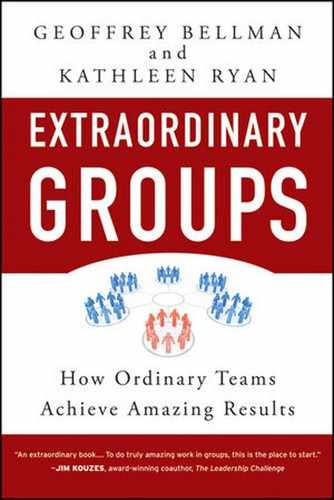When a group experience—like that of Tom and Fred described in Chapter Two—meets members' deep-seated, instinctive group needs, it sets a standard for groups in the future. People readily recall such experiences and describe them enthusiastically. It was "amazing," "wonderful,""hard to describe," "really something," or simply "wow!" This chapter gets beyond those vague exclamations and into the dynamics that support such zeal. Such exclamations result from individual needs being met; we explore those needs in our Group Needs model. They also represent certain feelings common to extraordinary groups; we elaborate on those. In the midst of all this is an elusive concept called "transformation"; we do our best to tie that down. Along the way through the chapter, we'll provide three illustrations from our field study. Let's begin with needs and our model before moving on to transformation and feelings.
As human beings, we have been grouping for a very long time, hundreds of thousands of years. We have evolved interdependently; we have survived as a species by facing the future together. We know it; our genes know it. In the ancient past, we came together for protection and procreation. Today, we come together to protect our shared identity and to pursue a purpose that will move us toward the future. Yet every twenty-first-century, stylishly outfitted, color-coordinated group is informed by more "primitive" instincts. The most logical, planning-oriented, analytical project team also lives in a world of nonrational, chaotic, emotion-driven instinctive needs. Our desires for inclusion, a sense of team, and a feeling of being a part of something greater than ourselves are all examples of those intuitive longings. We bring these very human needs to every group meeting. But what do we do with these deep set needs that we typically do not think of or talk about? Answering this question begins with understanding our needs.
Here's our proposition: As individuals, we all come to groups with a set of mostly unarticulated ancient needs that we long to meet through group experiences. This is true whether the group is a recreation league sports team, a problem-solving group at work, a nonprofit board of directors, or a family gathered around the kitchen table. In the pages ahead, these longings will be referred to as Group Needs. Because they represent deeply held yearnings, they are central to who we are as human beings and reside in the core of our instinctive selves. We present these needs in three pairs:
The three pairs join and overlap, creating a synergistic and transformative effect.
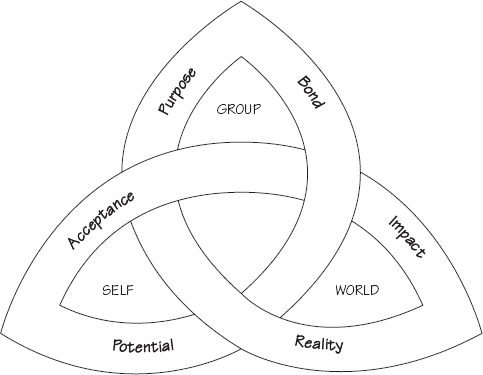
Three pairs of Group Needs form a knot of three interlaced loops. This ancient image can be traced back to 400 A.D.; its openness, continuous movement, and interconnection fit well with the interplay of the six Group Needs. We use this triple looped knot to frame how you can see the groups in your life. New possibilities reveal themselves when you see through the framework of this knot. Its six Group Needs and three loops are key to moving your group toward an extraordinary experience. Later, in Chapters Four, Five, and Six, we explore each pair of the six needs in detail. But first, an overview of the three loops.
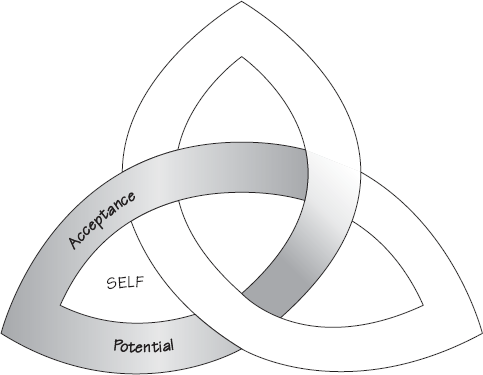
The two sides of this first loop express our need to accept ourselves and our need to become even more, embracing who we are while we reach toward who we could become. In groups we humans actively seek to meet these needs whether we know it or not, whether we can articulate them or not. They provide motives for much of what we do. Here's how we define each.
The two sides of the loop reveal the creative dynamic of simultaneously accepting ourselves in the moment and growing into our Potential. As we accept ourselves, we become more willing to step into situations that requiring us to stretch. A sense of our future selves can help us appreciate our current capabilities. Acceptance and Potential: different and inextricably linked. Consider the following example of how a group experience can help someone accept himself in the present and sharpen his Potential to make changes in the future.
Bruce worked for a large manufacturing company, quite contentedly developing technical training courses for front line employees. One day a request came in that changed both the direction of his career and how he saw himself at work. One of the unions asked the company for a ten-module course on basic electronics fully utilizing computer technology. This was at a time when computer-based-training was a new concept and not widely understood or used within Bruce's organization. No one individual in Bruce's work group was capable of responding to the request.
A team of four, including Bruce, was asked to assess the possibility of taking on the project. Bruce was a technical writer; his teammates included two instructional designers and one skills instructor. When they enthusiastically recommended that the project move ahead, they became the implementation team. For six months, these four worked together, breaking new ground for the company. Working with a vendor, they delivered the specific course to rave reviews, helped establish the value of computer-based-training, and developed a model for how the company would partner with outside vendors for similar courses in the future. This was cutting-edge work! As Bruce looked at their accomplishments, he said, "We built the capacity of the organization, resulting in a higher-quality educational experience at a lower cost."
But our focus is on Bruce's insights into himself. Demonstrating noteworthy self-Acceptance, he candidly told us, "I'm not a perfect team member. I have strong opinions and am sometimes inflexible. But I came to value the work of teams. In the past, I was more in control. Working on a team is different. But I learned that I liked working on a team better than working alone." Each of the other members of Bruce's group had "a passion for doing things right" and was inspired by the goal of building a high-quality product for the union. "We'd get into heated discussions about even trivial things. In the end though, we were better off because of it."
This experience encouraged Bruce to move toward his Potential in two ways—the focus of his career and how he conducted himself. He told us that "I'm not always right and I need to seek out other viewpoints. I learned to value other views and listen to them much better than before." As a result of this experience and a subsequent project, Bruce got seriously interested in groups and what makes them work. A career shift was the eventual result: "I started working with teams on more projects and eventually made my way into doing full-time organization development work for the company."
Bruce's experience enabled him to see his own strengths and challenges and it pushed him into a different way of working. As it did so, it reinforced his Acceptance of himself and launched his Potential, which included new behaviors and a different professional path. Chapter Four addresses Acceptance and Potential in more detail.

Most of us—hermits aside—want to live, work, and play in communities where our current and future selves are valued and supported. We bring our individual needs for Acceptance and Potential to a group where we meet others who bring those same longings. The group's declared Purpose creates the context for the relationships that develop as members of the group Bond with each other. The interplay between Bond and Purpose, in turn, encourages members' self-Acceptance and Potential. Let us offer some definitions:
Bond: Our shared sense of identity and belonging
Purpose: The reason we come together
Members show up hoping for a group to meet their needs to connect with others in a meaningful way. And so it is that the group offers a home—a place to be known and others to be known with. A place to be accepted, respected, and valued by others. A place that feels safe to contribute and discover. This intangible sense of "being on the same team"—of belonging—is what Bond is about. As bonded members join to pursue a common Purpose, they commit to something larger than themselves and their connection with one another. Through Purpose, they focus their attention, energy, skills, and communication—all within the context of a common compelling and unifying cause.
As with Acceptance and Potential, there is a creative and self-reinforcing dynamic between Bond and Purpose. Working together for a mutual Purpose allows members to get to know each other, thereby building their Bond. Increased appreciation for one another enables more concerted work toward Purpose. Creative thinking, collaboration, and commitment are common outgrowths of this interplay. Consider the following example of a group experience in which Bond and Purpose are particularly noticeable.
Allan sums up his group experience in this way: "This is the highest-performing team I've ever worked with." Which is saying something, given his forty-plus years of working in higher education, mental health services, and corporations in three different industries. Seven years ago, Allan was one of a small group of people who chose a positive, personal response to the September 11 attacks. They formed a donor's circle focused on small international development projects, making grants to people who might not otherwise have access to such funds. Examples include projects related to clean water, at-risk youth, small production agriculture, and preschool education in Asia, Latin America, or Africa. Members contribute $2,500 or $1,000 annually. They solicit proposals, recommend grantees, and then monitor the progress of the projects they fund—sometimes by visiting the projects. In 2002, they began with six members who granted $16,000 to three projects in one region of the world. At the end of 2008, there were forty-seven members funding twenty proposals amounting to $103,000 in three regions. Their contributions since 2002 exceed $250,000.
Sydney, a former scientist, joined the circle in 2006, not long after her retirement; she now finds herself the education chairperson and vice-president of the board. She sees the circle's Purpose as "a magnetic pull that brings us all together." When asked if she has been changed by the experience, her response was a resounding "Absolutely! I now spend twenty hours a week as a volunteer, have an incredible network of friends, and my worldview has expanded immeasurably."
Sydney's view is that the clear and powerful Purpose of the group creates a common framework in which decisions are made relatively easily, basically by consensus. A diverse membership includes strong and confident personalities, various ages and professional backgrounds, some who are wealthy, others who are not. Their meetings are characterized as "lively, with candor, and some joking and teasing. There's no complaining or criticism. It feels good—people are not uptight." Meetings typically begin with a potluck meal that encourages people to get to know each other better. And, of course, their various trips to remote parts of the world build strong connections with each other.
Allan reflects the group's Bond and Purpose saying, "There is great pride in what we are doing—that this is important and successful work. Not only in terms of our grantees and their work, but what we are each learning and how we engage more and more people locally in international philanthropy. This bonds us." He went on to say that "It's not that we've all become great friends. But there is genuine respect for what people bring and caring for each other. . . . Bond comes from the trust and respect that allows you to be yourself and be candid with others. They will listen and accept what you say. They will be candid with you. This is a very important part of the caring that goes on between people and what makes it possible to say things that feel risky."
Recently a conflict developed between a demanding founding member and someone new. Straight feedback, sensitively delivered, helped diffuse the conflict. Allan observed that when conflicts occur, "we communicate our way through to the other side." All members are drawn to the group's compelling Purpose; this makes it possible for them to "work things out and find a respectful compromise" rather than perpetuating conflicts or ending up in a situation where someone decides to leave the circle because of a disagreement.
Back and forth, Bond and Purpose reinforce one another, and in doing so, also make space for members to meet more self-oriented needs for Acceptance and Potential. Chapter Five addresses Bond and Purpose in more detail.
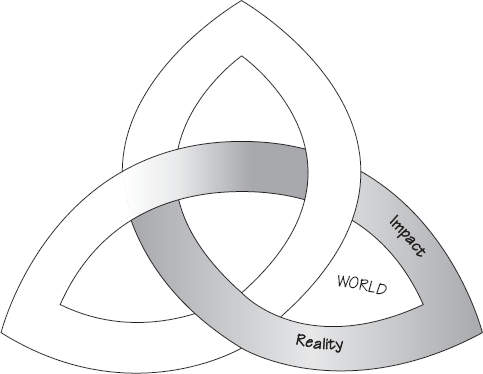
Depending on a group's Purpose, its "world" will vary. By this term, we mean the immediate setting that is most relevant to the group. This portion of the world may be as large as a corporation, an elementary school, a marketplace, a congregation, a city, a political constituency, or a family. Whatever it is, a group needs to understand its world in order to make a difference in it. The world Group Needs we each bring to groups are
Reality: Understanding and accepting the world as it is and how it affects us
Impact: Our intention to make a difference and our readiness to act
We are wired to survive; understanding our Reality is essential to that. As a species, our advancement has depended on being alert to the world around us. For groups to successfully fulfill their Purposes, members must demonstrate similar alertness; they need to see and accept the challenges and opportunities in front of them. When group members acknowledge Reality—rather than deny it—they increase the possibility of success.
Impact is about making a difference; it's about people coming together to make change for the better, moving their world a notch toward what they think that world ought to be. The creative dynamic between Reality and Impact can be highly pragmatic: when group members accept their Reality, they expand the possibility of Impact. This acceptance informs their strategies and actions. Or, perhaps more optimistically, with this understanding they can intentionally choose not to be limited by the real-world circumstances they face. Here's a story that illustrates these two Group Needs.
Bob's employer manufactured, sold, and repaired sophisticated measurement instruments in the United States and overseas. In 2004, he faced an uncomfortable Reality: company cost reductions moved him from being a highly successful manufacturing manager to being an individual contributor. The reassignment saved his job but left him with no group to lead. And the company was seeking still greater cost reductions. Bob was assigned to the outsourcing team, a group of peers without a designated leader, charged with developing a new outsourcing strategy that would continue to produce savings. His new coworkers included three engineers, a purchasing expert, and a finance person.
The Impact of this outsourcing team has been very impressive. Their goal was to save $2 million in 2004; they saved $2.3 million. In 2005, they saved an additional $2.5 million, won the company's Innovation Award, and Bob was made manager of the group. By 2006, they had reduced costs over $2 million each year, for a total savings of $8.8 million. And how did they do it? They partnered with a U.S. vendor that could perform work that had previously been sent to one of the company's facilities in Malaysia. Partnering with this vendor achieved great savings and brought work and jobs back to the United States. It also required close cooperation between this new outside vendor and one factory.
A new Reality came as a consequence of work with the vendor: people in one factory—where Bob had formerly managed 200 people—were afraid the outsourcing team's work would lead to job loss. This plant had had multiple rounds of lay-offs over two years, and workers were concerned their jobs could go elsewhere. The outsourcing team was the bridge between the factory and the vendor; it became the target of factory workers' fears. For the outsourcing to be successful, vendor employees needed to learn to work with the instruments—and they needed to learn those skills from factory workers. The cooperation of plant workers was essential.
The team gathered for a day-long retreat, with a "pretty clear understanding of our purpose and the world we were operating in—how much we needed to save without taking a hit on any of the other business metrics." Bob recalls that "We set about learning each others' expertise and style, which turned out to be nicely complementary. And we realized we really needed each other's help." They redefined their roles and how they would work together. Every member took on a unique role based on his expertise and experience; a new sense of team cooperation emerged. Their collaborative plan was based on their shared assessment of Reality; collectively facing their challenges pulled the team together.
After the retreat, the finance person facilitated meetings; the purchasing person acted as an account manager with the vendor. The engineers figured out the process and cost of delivery issues. Because of Bob's experience in the plant where the fears had surfaced, he knew how to secure cooperation between plant employees and the vendor: managers would talk with each of the affected plant employees about the assignments they would move to when the current work was outsourced. Communication within the outsourcing team became relatively easy. As Bob commented, "It was hard to hide in a group of six. If people were holding back, they would be drawn out." They generally made their decisions by consensus but in certain cases deferred to the expertise of others.
Looking at the Impact of their work, Bob reflected on both the tangible and intangible results of the group's work. "At the start, there was no sense of 'we.' " But as the work evolved, "It was an amazing experience. It was an opportunity to solve a problem, to do something others thought was too hard to do, and to work with other competent people—on a project where we each could win!"
Let's look at the Group Needs model again, considering how each of the three loops is present in the Outsourcing Team's experience.
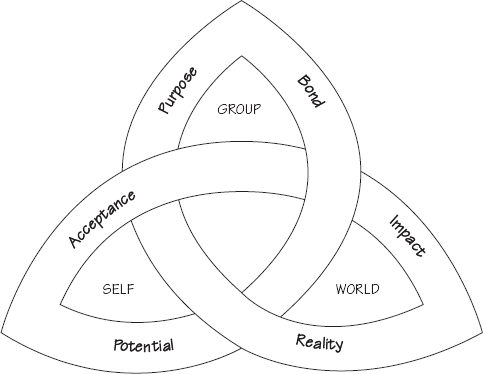
Without an understanding of the challenges (Reality) they faced, the Outsourcing Team could not have met and surpassed the expectations set for them (Impact). Confident team members (Acceptance) brought the necessary and complementary talents to their common goal (Purpose). They paid attention to how they worked together and supported each other's success (Bond), which reinforced their collective ability to have Impact. At least four of the group members expanded their skills in team building, influencing, or organizing in ways that prepared them for future roles (Potential). See Chapter Six for more detail on Reality and Impact.
When so many of group experiences are ordinary, people delight when a group stands out as unusual and positive—groups like those Bruce, Bob, Allan, and Sydney experienced. In all sixty stories in our field study, at least three Group Needs were met. In fact, in the vast majority of cases, at least five of the six Group Needs were met. No wonder people could vividly recall those transforming groups!
Chapter Two discussed the eight indicators you are likely to see at work in extraordinary groups. And why do those indicators stand out? Because they meet the needs people bring to groups. And how do people feel when that happens? That's where we go next as we explore the feelings that come when Group Needs are met and transformation occurs.
With the overview of the six Group Needs in place, we now describe what we mean by transformation and how it happens in groups. Among the questions asked in our interviews were these two: How were you changed by this experience? And What words would you use to describe this powerful experience? We collected literally hundreds of responses, studied them for patterns, and came to the conclusions we review in the rest of this chapter. Let's begin with a definition and elaborate on it with stories from earlier in the chapter:
Transformation is a fundamental shift in individual perceptions that accelerates behavior change and personal vitality.
We are not talking incremental change; we are not talking linear, logical movement. We are talking "the earth moved," "our bearings have shifted," "I now see it differently." This shift can be so subtle as to seem small from an outside perspective, but the internal personal experience is profound.
When perceptions shift at a fundamental level, the way an individual sees is altered; he has a new lens through which to view his world. For example, Bruce shifted from preferring to be an individual contributor to someone who wanted to work in teams. Allan shifted toward a more realistic view of the complex issues related to giving money internationally; he became more respectful of grantees and humble about his own circumstances. Sydney shifted the way she sets her priorities for her time and money. Bob learned the value of a "leader-less" group and how he could contribute to the group as a member and not the leader.
Individuals find themselves acting to support their new view of the world. They scramble to take advantage of it; they rededicate themselves, often giving more of themselves, working harder, longer, and differently with renewed purpose. Bruce began to listen more. Allan became more willing to compromise. Sydney convinced her family members to give donations to work in Kenya rather than holiday gifts to one another. Bob practiced being a team member, rather than a take-charge leader.
Because of the shift in perception, the individual feels more alive, more committed, connected, and contributing. That feeling is contagious within a group of individuals, transformed or not. The expression of alive feelings among people is often the first indicator that something transformative has occurred. Bruce took away the sense that teaming with each other could be more fun, with more laughing, than he had ever imagined. Allan has seen that his work with the donors' circle "brings forth my best self." Sydney awakens eager to turn on her computer to see the news from those she has met around the world. Bob understands that his experience moved him from proposing teamwork—as he did when he managed manufacturing groups—to living it, now knowing "this stuff really works!"
Those interviewees who felt they were transformed as defined in this chapter all experienced a similar set of four feelings. These four feelings fit with both individual and group transformative experiences, whether those of corporate planners, canoe trippers, ball players, software engineers, soldiers, college professors, or motorcyclists. All readily recognize these feelings. As varied as their purposes and uniforms, tools and contexts might be, this diverse array of people shared the same satisfaction. The feelings resulting from meeting their needs would show in their affirmative responses to these four questions:
Did this experience energize you? Yes!
Did you feel more deeply connected to your group or the world around you? Yes!
Did you feel more hopeful about yourself, your group, or the world around you? Yes!
Did you feel changed by this experience? Yes!
Four yeses point toward a transforming experience, as seen in this chapter's three stories. And when those affirmative answers are widely and enthusiastically expressed across a group, a transformative experience for many has probably occurred. Look for comments like, "What an exciting group! . . . I love our meetings! . . . You guys are great! . . . Look at what we've been able to accomplish!" If these questions and answers seem far removed from what your group might currently express, that could be a rough calculation of your distance from a transformative experience. Let's consider each of these four key feelings.

A sense of vitality increases as members engage with the group and the world. The sixty people we interviewed were all energized by recalling their experiences—even the one who didn't think he had been changed by the experience, or the four whose groups fell short of their desired Impact. These people became animated as they told their stories; they loved recreating the experience for us and for themselves. Just listening to them mirrored the high engagement and total investment that they experienced at the time. As you watch your groups, this energy will show as the group interacts; you will notice how alive the group is from one moment to the next; members will notice their vitality as it is sparked or dampened in group exchange. Vitality becomes a common, quick measure of what is happening, as in, "Does this have life for us?" Or "What about this project brings energy to you?"
People are often surprised at how connected they feel with their group. They were typically astounded by their feelings of being tightly bonded with other group members who at the beginning seemed so different from themselves. For some, it was the most accepting group they had ever been part of. They were uniquely, even permanently joined. It was not uncommon that people who told us about twenty-year-old experiences could put us immediately in touch with others who had been in the group. We heard these comments about the connections people felt with one another: "We bonded for life." "There was an informal heart-and-soul group made up of those who were willing to do whatever was necessary." "When I took this job, I thought I'd only be here for two years. The team and mission have kept me here for seven." Members personally connect to each other, to the group itself, to its Purpose, and to the difference they make together.
As people told their stories, we could hear the hope implied in all that the group did as it moved toward creating a better product, place, or world. Because of what their groups did and because they were part of it, people leaned toward the future with a more optimistic outlook. They held the sense that they were making a difference on something important. Hopefulness is further fed by the fact a uniquely capable group is doing this together. If there were more groups like this in the world, there would be less to worry about! Some examples of what we heard: "Each of us represented different nationalities. Somehow we met in the universe with different values and we discovered that we speak the same language and have so much in common!" "There are no boundaries for what we can do. We can be in a completely free creation mode." "I have experienced the power of our ability to positively influence kids who could go either way. They are ready and willing when we give them the skills. We see it in front of our eyes. It's quite incredible!" "I can help others by helping myself and utilizing all of my skills. This has made me feel relevant and useful. Together we have a sense of how it can be different." And the hope they have created here is contagious. It tells them what just might be possible in other realms of their lives.
All but one person we interviewed affirmed that they saw changes in themselves that could be tied directly to the group they told us about. For some, the change was dramatic and noticeable. For example: "It's made my life livable." For others, the change was more subtle: "It confirmed what I have believed for some time." Some saw immediate impact: "I immediately knew that I was not alone. I had a global network of people I could call at any time—no matter what." Others sensed the power of the experience over time: "The work didn't seem like work anymore. My whole way of thinking about my work changed. I wanted to be the Charlie Parker of computer skills training. I wanted it to be like jazz—a bunch of really talented people working in chaos to make something beautiful." Each quote is testimony to how things will never be quite the same again.
To summarize, when you feel energized, connected, hopeful, and changed, you've probably had a transformative experience. When you ask others in your group about how they feel, and their responses fit with these four feelings, your group has probably been through something transforming and terrific together! All of this comes together visually in this illustration.
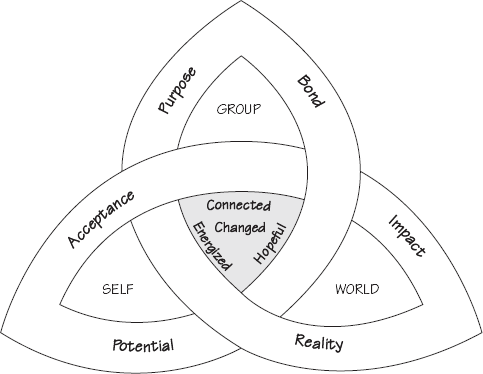
In a group, how to we get to these four feelings? First, by attending to the six Group Needs: Acceptance and Potential, Bond and Purpose, Reality and Impact. People will feel energized, connected, hopeful, and changed as their Group Needs are met. Second, by behaving in ways that demonstrate the eight indicators highlighted in Chapter Two. If you were sitting in the back of the room watching an extraordinary and transforming group, you'd see signs of a compelling purpose, shared leadership, just-enough-structure, embracing differences, full engagement, unexpected learning, strong relationships, and great results. Such actions also trigger feelings of being energized, connected, hopeful and changed. Let's look more concretely at how this happens.
We have described the six Group Needs as instinctive or intuitive or unconscious. When two or more of those needs are met, the impact is felt within nonrational, emotional, very human territory. As we go about our daily routines, we humans operate simultaneously on at least two tracks. Think of them as the "head" and the "heart." Each is associated with elements that shape how we experience life, the meaning we take from it, and the behaviors we choose. For example, consider this table:
Head | Facts | Logic | Analysis | Knowing | Practical | Transition |
Heart | Emotions | Intuition | Meaning | Sensing | Passionate | Transformation |
Especially at work, the head gets lots of attention. Think of job descriptions, plans, roles, decisions, data reports, metrics, and organizational charts. All are useful in joining people for accomplishment. And the head is just part of the person. When people in our field study used short phrases to describe their transformative experiences, passion, emotion, and enthusiasm were the pattern. The enthusiasm people express describing their extraordinary groups told us that to understand transformation, we needed to explore terrain beyond analysis and logic, beyond the head and into the heart.
Our experience and our field study reinforce that transformation happens first as a unique experience for the individual. It happens one person at a time and it happens differently for each person—though the expression of that experience will have much in common with the expressions of others. Someone can consciously expose a group to experiences that make transformation more likely, but in the end each member will experience transformation in a private and personal way.
When this group-shift does happen, the effect is electric. What happens for one group member resonates with others, making a similar reaction more likely. Members feed on each other's energy, caught up in what is happening around them. Our guidance on how to meet Group Needs can make this more likely, but group transformation isn't delivered through linear steps or a formula. You can make it more likely, but in the end you must yield to forces in the moment, to chance, to intuition. These are the moments that people describe as "magical."
There is no way to guarantee transformation. We wish there were. But transformation is simply too private and subjective a process to be controlled or predicted by another person. Transformation often happens quietly without a lot of fanfare or external recognition—even when it turns out to be tremendously significant. For the most part, the powerful shift of perspective is recognized only after it happens. Similarly, the power of the shift cannot be judged by anyone else. We can only make these judgments for ourselves.
We are convinced that you can significantly increase the likelihood of individual and group transformation. In story after story, we heard of multiple Group Needs being met in experiences that people saw as amazing. Group members, leaders, and facilitators behaved in ways that fit with creating a transformed group. Consider what you could do to help one of your groups move from ordinary to extraordinary. What might you do or say that would cause others—or yourself—to feel energized, connected, hopeful, and changed?
Parts Two and Three of this book will help you think more about this.
